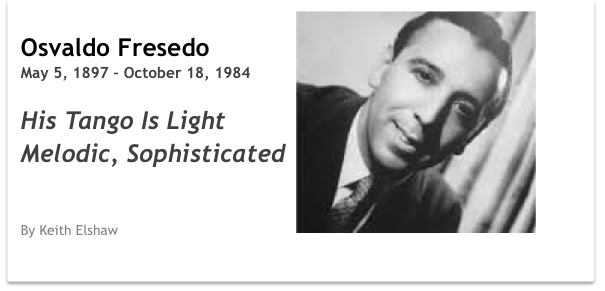Take it from me, the 200 year old DJ, there's a time pretty much every night when you have to reach for a Fresedo tanda to do a specific thing you need right now. And the larger your crowd, the more you need him for the perfect assist he gives you in your moment of need.
His early records bring: beautiful melodies, beautiful moods; relief from intensity; suggestions for movement dancers will find refreshing; a breath of fresh air. (His later records, 40s onward, bring pretty much darkness and depression (subjective opinion) so don't go there in a milonga.!
The sound quality of his early records is pretty good, right? Well ... except for some creep at a record company thinking in later years that adding echo to them would be a terrific idea. That virus introduction has come down into everything available today.
I am happy to play for you what he is supposed to sound like! Compare this to the version you have ...
Fresedo Orquesta (1933) - La clavada
The most interesting of the tango orquestas are the ones who fashioned a unique, instantly recognizable sound.
Elegant, sophisticated, urbane - using vibes, harp, percussion and other orchestral possibilities, Fresedo created his own kind of tango music and in so doing left a wonderful legacy of dreamy dance music.
Osvaldo composed, among other songs, El Once, Vida Mia, Arrabalero, Aromas, Pampero, Pimienta and a sweet little number that I love, Sollozos.
Known as "El pibe de la Paternal," Osvaldo Nicolás is from the so-called 1910 generation - one of the sedate and gentle ones.
As a player, he was in groups led by Firpo and Canaro. He started his own quartet in 1918 employing musicans such later well-known musicians as Julio De Caro (!) and Hugo Baralis. He recorded first in the U.S. with Orquesta Típica "Select,". He played on two Gardel recordings in 1925 (Fea and Perdó viejita). Later in that decade, he played in movies houses hiring the young, unknown, just arrived in town Carlos Di Sarli who aspired to make music like Fresedo.
From the beginning as a leader, he developed a soft, staccato rhythmic approach which became his signature.
His featured singer in the 30s, Roberto Ray, was just fantastic and fills halls today with a special quality of delivery. He always pushes the peoples' swoon button every time he comes on.
In 1956 he made a landmark recording collarboration with wonderful Dizzy Gillespie. To me, it's not for dancing - but it sure is interesting.
Fresedo for many becomes more interesting the more one gets deeper into tango. It's the same for a dj. I use him to give me a broader canvas to work on. His music is fabulous as a mood transitioner in a milonga.

